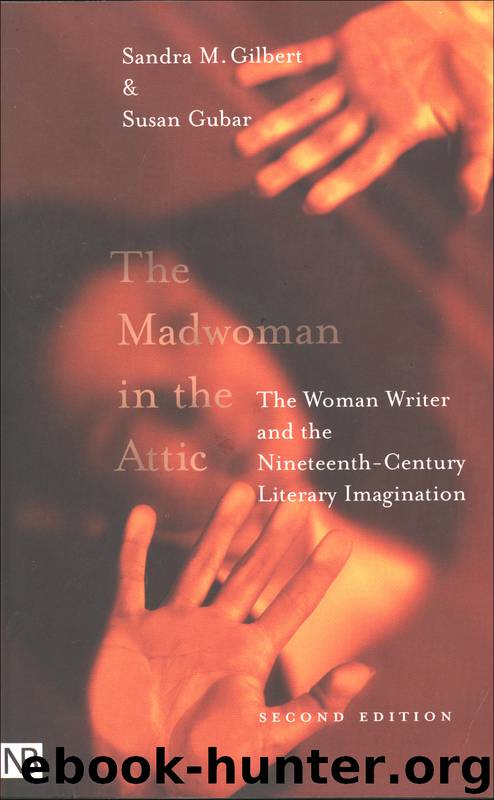The Madwoman in the Attic by Sandra M. Gilbert & Susan Gubar

Author:Sandra M. Gilbert & Susan Gubar
Language: eng
Format: epub
Publisher: Yale University Press
Published: 1979-03-03T16:00:00+00:00
Jane’s first meeting with Rochester is a fairytale meeting. Charlotte Brontë deliberately stresses mythic elements: an icy twilight setting out of Coleridge or Fuseli, a rising moon, a great “lion-like” dog gliding through the shadows like “a North-of-England spirit, called a ‘Gytrash’ which … haunted solitary ways, and sometimes came upon belated travellers,” followed by “a tall steed, and on its back a rider.” Certainly the Romanticized images seem to suggest that universe of male sexuality with which Richard Chase thought the Brontës were obsessed.18 And Rochester, in a “riding-cloak, fur-collared, and steel-clasped,” with “a dark face … stern features and a heavy brow” himself appears the very essence of patriarchal energy, Cinderella’s prince as a middle-aged warrior (chap. 12). Yet what are we to think of the fact that the prince’s first action is to fall on the ice, together with his horse, and exclaim prosaically “What the deuce is to do now?” Clearly the master’s mastery is not universal. Jane offers help, and Rochester, leaning on her shoulder, admits that “necessity compels me to make you useful.” Later, remembering the scene, he confesses that he too had seen the meeting as a mythic one, though from a perspective entirely other than Jane’s. “When you came on me in Hay Lane last night, I … had half a mind to demand whether you had bewitched my horse” (chap. 13). Significantly, his playful remark acknowledges her powers just as much as (if not more than) her vision of the Gytrash acknowledged his. Thus, though in one sense Jane and Rochester begin their relationship as master and servant, prince and Cinderella, Mr. B. and Pamela, in another they begin as spiritual equals.
As the episode unfolds, their equality is emphasized in other scenes as well. For instance, though Rochester imperiously orders Jane to “resume your seat, and answer my questions” while he looks at her drawings, his response to the pictures reveals not only his own Byronic broodings, but his consciousness of hers. “Those eyes in the Evening Star you must have seen in a dream…. And who taught you to paint wind? … Where did you see Latmos?” (chap. 13). Though such talk would bewilder most of Rochester’s other dependents, it is a breath of life to Jane, who begins to fall in love with him not because he is her master but in spite of the fact that he is, not because he is princely in manner, but because, being in some sense her equal, he is the only qualified critic of her art and soul.
Their subsequent encounters develop their equality in even more complex ways. Rudely urged to entertain Rochester, Jane smiles “not a very complacent or submissive smile,” obliging her employer to explain that “the fact is, once for all, I don’t wish to treat you like an inferior … I claim only such superiority as must result from twenty years difference in age and a century’s advance in experience” (chap. 14). Moreover, his long account of his
Download
This site does not store any files on its server. We only index and link to content provided by other sites. Please contact the content providers to delete copyright contents if any and email us, we'll remove relevant links or contents immediately.
| African | Asian |
| Australian & Oceanian | Canadian |
| Caribbean & Latin American | European |
| Jewish | Middle Eastern |
| Russian | United States |
4 3 2 1: A Novel by Paul Auster(11100)
The handmaid's tale by Margaret Atwood(6895)
Giovanni's Room by James Baldwin(5935)
Big Magic: Creative Living Beyond Fear by Elizabeth Gilbert(4762)
Asking the Right Questions: A Guide to Critical Thinking by M. Neil Browne & Stuart M. Keeley(4625)
On Writing A Memoir of the Craft by Stephen King(4247)
Ego Is the Enemy by Ryan Holiday(4020)
Ken Follett - World without end by Ken Follett(3992)
The Body: A Guide for Occupants by Bill Bryson(3859)
Bluets by Maggie Nelson(3743)
Adulting by Kelly Williams Brown(3703)
Guilty Pleasures by Laurell K Hamilton(3615)
Eat That Frog! by Brian Tracy(3548)
White Noise - A Novel by Don DeLillo(3453)
The Poetry of Pablo Neruda by Pablo Neruda(3387)
Alive: The Story of the Andes Survivors by Piers Paul Read(3334)
The Book of Joy by Dalai Lama(3258)
The Bookshop by Penelope Fitzgerald(3248)
Fingerprints of the Gods by Graham Hancock(3239)
